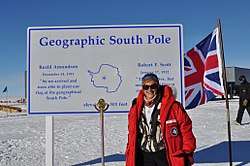Julie Palais
| Julie Michelle Palais | |
|---|---|
 Julie Michelle Palais at the South Pole | |
| Born |
September 2, 1956 Massachusetts |
| Nationality | United States |
| Alma mater | University of New Hampshire |
| Organization | Division of Polar Programs, USA |
Julie Michelle Palais (born September 2, 1956 in Massachusetts) is an award-winning polar glaciologist who has made great contributions to climate change research studying volcanic fallout in ice cores from both Greenland and Antarctica. Since 1990, she has played a pivotal role working at the National Science Foundation as Program Director of the Antarctic Glaciology Program in the Division of Polar Programs. Both the Palais Glacier and Palais Bluff in Antarctica were named in her honor. She has made twenty-eight trips to Antarctica and three trips to Greenland, and was the co-recipient of the Explorer Club's Lowell Thomas Award.
Early life and education
Palais attended Newton North High School in Massachusetts, graduating in 1974. In 1978 she received her Bachelor of Arts (BA) cum laude in Geology/Earth Science from the University of New Hampshire. She attended The Ohio State University between 1978 and 1985, where she earned both a Master of Science (MS) and a Doctor of Philosophy (PhD) in Geological and Earth Sciences/Geosciences. Her graduate research focused on the study of volcanic fallout in snow and polar ice cores from both Greenland and in samples from the Byrd ice core and from shallow ice cores near Mt. Erebus on Ross Island in Antarctica.
Career and impact
For more than 26 years, Palais has directed polar glaciology research and served as Program Director for the Division of Polar Programs Antarctic Glaciology Program at the National Science Foundation.[1]
As both a researcher and a director, Palais has made more than 27 trips to Antarctica and 3 trips to Greenland. In an effort to understand the history and dynamics of the Antarctic and Greenland ice sheets, research programs focus on various glaciology aspects including the use of ice cores as global paleoclimate indicators.
Palais is a member of numerous professional societies including the American Geophysical Union, the International Glaciological Society, the American Polar Society, the Explorers Club and the Animals and Society Institute.
Awards and honors
Palais Glacier and Palais Bluff are two features in Antarctica which have been named in her honor. Palais Glacier was named in 1995,[2] and Palais Bluff was named in 2000[3] by the Advisory Committee on Antarctic Names (US-ACAN).
In 2007, the Explorers Club named her co-recipient of the Lowell Thomas Award for her contributions to breakthroughs in glaciology and climate science.[4]
In 2017, the International Glaciological Society awarded Palais the Richardson Medal for 'For insightful and steadfast service to the U.S. and international glaciological and ice core science communities by enabling discoveries that have impacted the course of climate science and enlightened understanding of the important role of glaciology and the polar regions in global climate change'.[5]
References
- ↑ "Julie Palais | National Science Foundation". www.nsf.gov. Retrieved 2016-07-17.
- ↑ "Palais Glacier, Antarctica - Geographical Names, map, geographic coordinates". www.geographic.org. Retrieved 2016-07-17.
- ↑ "Palais Bluff, Antarctica - Geographical Names, map, geographic coordinates". www.geographic.org. Retrieved 2016-07-17.
- ↑ "Explorers Club to Honor NSF-Funded Researchers and Glaciologist for Climate-Science Breakthroughs | NSF - National Science Foundation". www.nsf.gov. Retrieved 2016-07-17.
- ↑ "Richardson medal awardee 2017 - Julie M. Palais". www.igsoc.org.